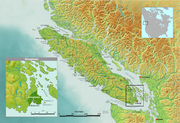
Songhees
Encyclopedia

Coast Salish
Coast Salish languages are a subgroup of the Salishan language family. These languages are spoken by First Nations or Native American peoples inhabiting the territory that is now the southwest coast of British Columbia around the Strait of Georgia and Washington state around Puget Sound...
people who reside on southeastern Vancouver Island
Vancouver Island
Vancouver Island is a large island in British Columbia, Canada. It is one of several North American locations named after George Vancouver, the British Royal Navy officer who explored the Pacific Northwest coast of North America between 1791 and 1794...
, British Columbia
British Columbia
British Columbia is the westernmost of Canada's provinces and is known for its natural beauty, as reflected in its Latin motto, Splendor sine occasu . Its name was chosen by Queen Victoria in 1858...
in the Greater Victoria area. There is evidence of a fortified village existing at Finlayson Point in Beacon Hill Park
Beacon Hill Park
Beacon Hill Park is a 75 ha park located along the shore of Juan de Fuca Strait in Victoria, British Columbia. The park is popular both with tourists and locals, and contains a number of amenities including woodland and shoreline trails, two playgrounds, a waterpark, playing fields, a petting...
prior to the arrival of Europeans in the late eighteenth and early nineteenth centuries. The Songhees' traditional foods included salmon, shellfish, whale, deer, duck, berries, camas root
Camassia
Camassia is a genus of six species native to western North America, from southern British Columbia to northern California, and east to Utah, Wyoming and Montana...
, and herbs. The Coast Salish traditionally lived in bighouses.
The Songhees population was estimated to be 8,500 in 1859 but by 1914 had dwindled to less than 200.
At the time of the establishment of Fort Victoria
Fort Victoria (British Columbia)
Fort Victoria was a fur trading post of the Hudson’s Bay Company, the headquarters of HBC operations in British Columbia. The fort was the beginnings of a settlement that eventually grew into the modern Victoria, British Columbia, the capital city of British Columbia.The headquarters of HBC...
by the British in 1843, a Songhees village was situated adjacent to the fort. The village was subsequently moved across Victoria Harbour in what is now the Victoria West neighbourhood. The village was subsequently moved and a reserve
Indian reserve
In Canada, an Indian reserve is specified by the Indian Act as a "tract of land, the legal title to which is vested in Her Majesty, that has been set apart by Her Majesty for the use and benefit of a band." The Act also specifies that land reserved for the use and benefit of a band which is not...
established adjacent to what is now the municipality of View Royal.
Sir James Douglas
James Douglas (Governor)
Sir James Douglas KCB was a company fur-trader and a British colonial governor on Vancouver Island in northwestern North America, particularly in what is now British Columbia. Douglas worked for the North West Company, and later for the Hudson's Bay Company becoming a high-ranking company officer...
, governor of Vancouver Island
Vancouver Island
Vancouver Island is a large island in British Columbia, Canada. It is one of several North American locations named after George Vancouver, the British Royal Navy officer who explored the Pacific Northwest coast of North America between 1791 and 1794...
negotiated a treaty with the Songhees in 1850. Much of the traditional territory of the Songhees now forms the core of the urbanized area of Victoria and surrounding municipalities. The development of British Columbia's capital city caused considerable disruption to the Songhees' traditional economy and livelihood.
Recently the Songhees considered that the government of British Columbia had failed to honour the 1850 treaty and commenced a legal action against the province and the government of Canada
Canada
Canada is a North American country consisting of ten provinces and three territories. Located in the northern part of the continent, it extends from the Atlantic Ocean in the east to the Pacific Ocean in the west, and northward into the Arctic Ocean...
for redress. A settlement of the action was announced in November 2006 by Songhees Chief Robert Sam, the federal Minister of Indian Affairs and Northern Development Jim Prentice and the provincial Minister of Aboriginal Relations and Reconciliation, Mike de Jong.
Their government is the Songhees First Nation
Songhees First Nation
The Songhees First Nation is a First Nations government on located around Victoria, British Columbia on southern Vancouver Island, British Columbia, Canada.-External links:*...
, a member of the Te'mexw Treaty Association
Te'mexw Treaty Association
The Te'mexw Treaty Association handles Treaty negotiations in the BC Treaty Process for a number of First Nations located in the northern Strait of Georgia of British Columbia. The members of the association are former signatories of the Douglas Treaties, a group of treaties signed in...
and the Naut'sa Mawt Tribal Council
Naut'sa Mawt Tribal Council
Naut’sa mawt Tribal Council is a First Nation Tribal Council located in British Columbia, Canada, with offices in Tsawwassen and Nanaimo. NmTC advises and assists its 11 member Nations in the areas of Community Planning, Economic Development, Financial Management, Governance and Technical Services...
. Their traditional language is a dialect of the North Straits Salish language
North Straits Salish language
North Straits Salish is a Salish language which includes the dialects of Lummi, Samish, Saanich, Semiahmoo, Songish, and Sooke. Although they are mutually intelligible, each dialect is traditionally referred to as if they were separate languages, and there is no native term to encompass them...
.

